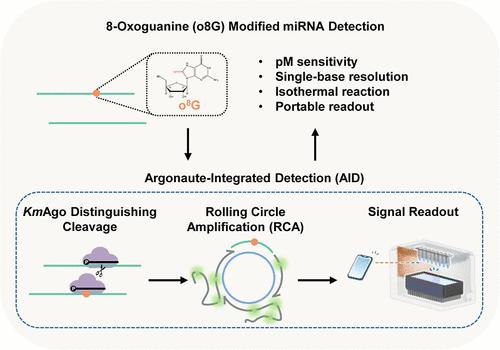argonaute -偶联滚动圈扩增技术能够快速、灵敏地检测8-氧鸟嘌呤修饰的miRNA
IF 9.1
1区 化学
Q1 CHEMISTRY, ANALYTICAL
引用次数: 0
摘要
8-氧鸟嘌呤(o8G)是一种与衰老、癌症和心血管疾病相关的重要氧化RNA修饰,由于其结构的不稳定性和序列依赖性的致突变作用,给检测带来了重大挑战。目前的方法难以实现快速和敏感地鉴定o8g修饰的microRNAs (miRNAs),特别是在用户友好的操作中。为了解决这一限制,开发了一种Argonaute -integrated detection (AID)系统,该系统将中温嗜酸性Argonaute (Ago)的序列特异性裂解活性与滚动圈扩增(RCA)协同作用,用于o8g修饰的靶标选择性扩增和定量。我们的策略利用Ago的独特特性来阻止o8g修饰的miRNA内的切割,使未修饰的rna能够选择性切割,同时保留o8g修饰的miRNA用于随后的rca介导的信号放大。AID平台实现了单核苷酸分辨率的皮摩尔灵敏度。该工作流程的等温反应允许集成到现场可部署的设备中,该设备能够通过肉眼或智能手机进行视觉读取,并在数小时内证明o8g修饰rna的pM检测极限。这种便携系统结合了分子特异性和操作简单性,通过快速检测氧化RNA生物标志物而不需要昂贵的设备,为临床诊断提供了潜力,同时也为相关疾病的表观遗传调控机制研究提供了一种多功能工具。本文章由计算机程序翻译,如有差异,请以英文原文为准。

Argonaute-Coupled Rolling Circle Amplification Enables the Rapid and Sensitive Detection of 8-Oxoguanine-Modified miRNA
8-Oxoguanine (o8G), a prominent oxidative RNA modification linked to aging, cancer, and cardiovascular pathologies, presents significant detection challenges due to its structural lability and sequence-dependent mutagenic effects. Current methodologies struggle to achieve rapid and sensitive identification of o8G-modified microRNAs (miRNAs), particularly in user-friendly operations. To address this limitation, an argonaute-integrated detection (AID) system was developed that synergizes the sequence-specific cleavage activity of mesophilic Argonaute (Ago) with rolling circle amplification (RCA) for the o8G-modified target selective amplification and quantification. Our strategy exploits the unique property of Ago to stall cleavage within o8G-modified miRNAs, enabling the selective cleavage of unmodified RNAs while preserving o8G-modified miRNA for subsequent RCA-mediated signal amplification. The AID platform achieved picomolar sensitivity with a single-nucleotide resolution. The isothermal reaction of this workflow permitted integration into a field-deployable device capable of the visual readout by the naked eye or smartphone, demonstrating a detection limit of pM for o8G-modified RNAs within hours. This portable system combines molecular specificity with operational simplicity, offering potential for clinical diagnostics through the rapid detection of oxidative RNA biomarkers without the need of expensive equipment, while also providing a versatile tool for mechanistic studies of epigenetic regulation in related diseases.
求助全文
通过发布文献求助,成功后即可免费获取论文全文。
去求助
来源期刊

ACS Sensors
Chemical Engineering-Bioengineering
CiteScore
14.50
自引率
3.40%
发文量
372
期刊介绍:
ACS Sensors is a peer-reviewed research journal that focuses on the dissemination of new and original knowledge in the field of sensor science, particularly those that selectively sense chemical or biological species or processes. The journal covers a broad range of topics, including but not limited to biosensors, chemical sensors, gas sensors, intracellular sensors, single molecule sensors, cell chips, and microfluidic devices. It aims to publish articles that address conceptual advances in sensing technology applicable to various types of analytes or application papers that report on the use of existing sensing concepts in new ways or for new analytes.
 求助内容:
求助内容: 应助结果提醒方式:
应助结果提醒方式:


